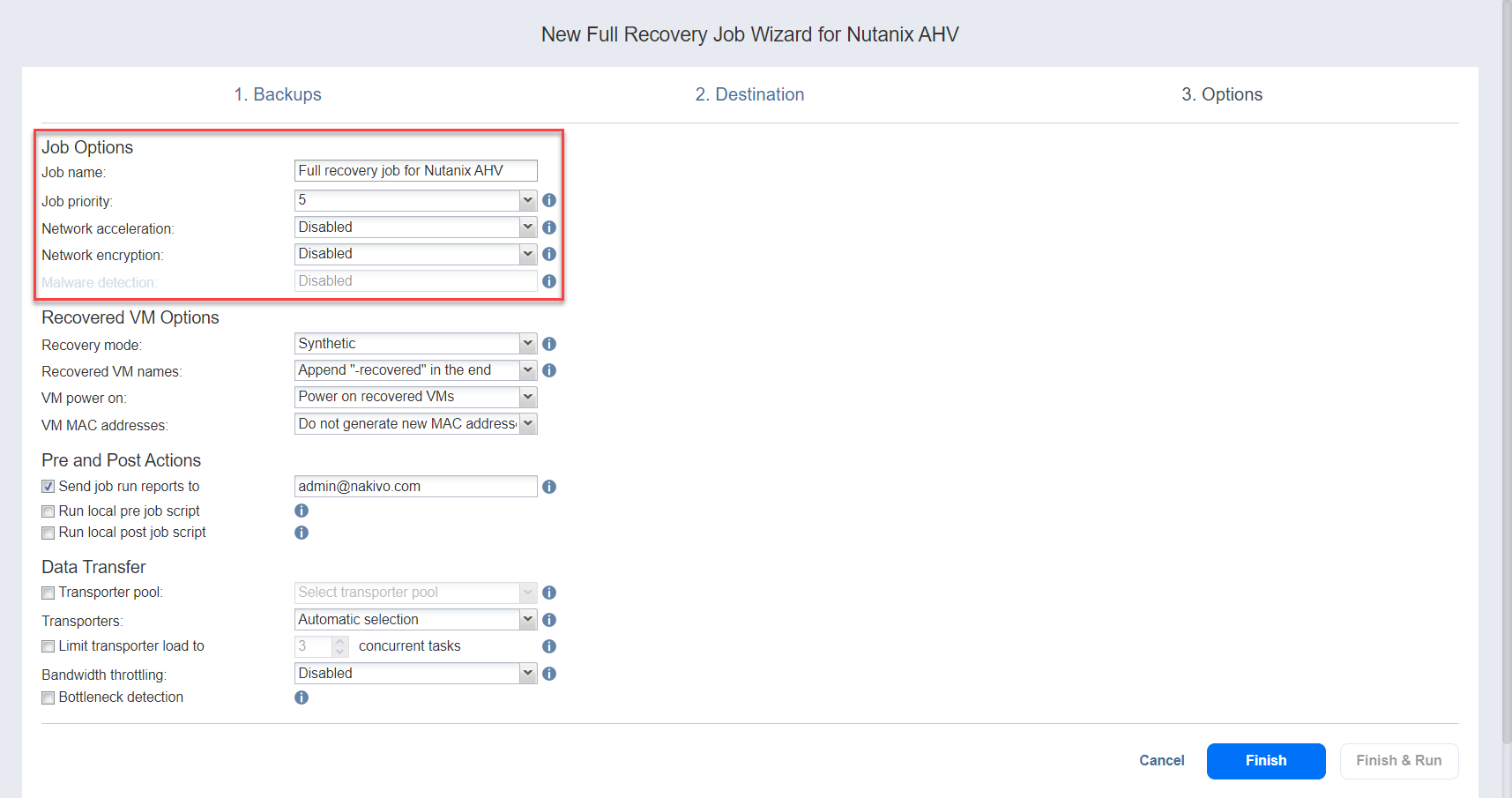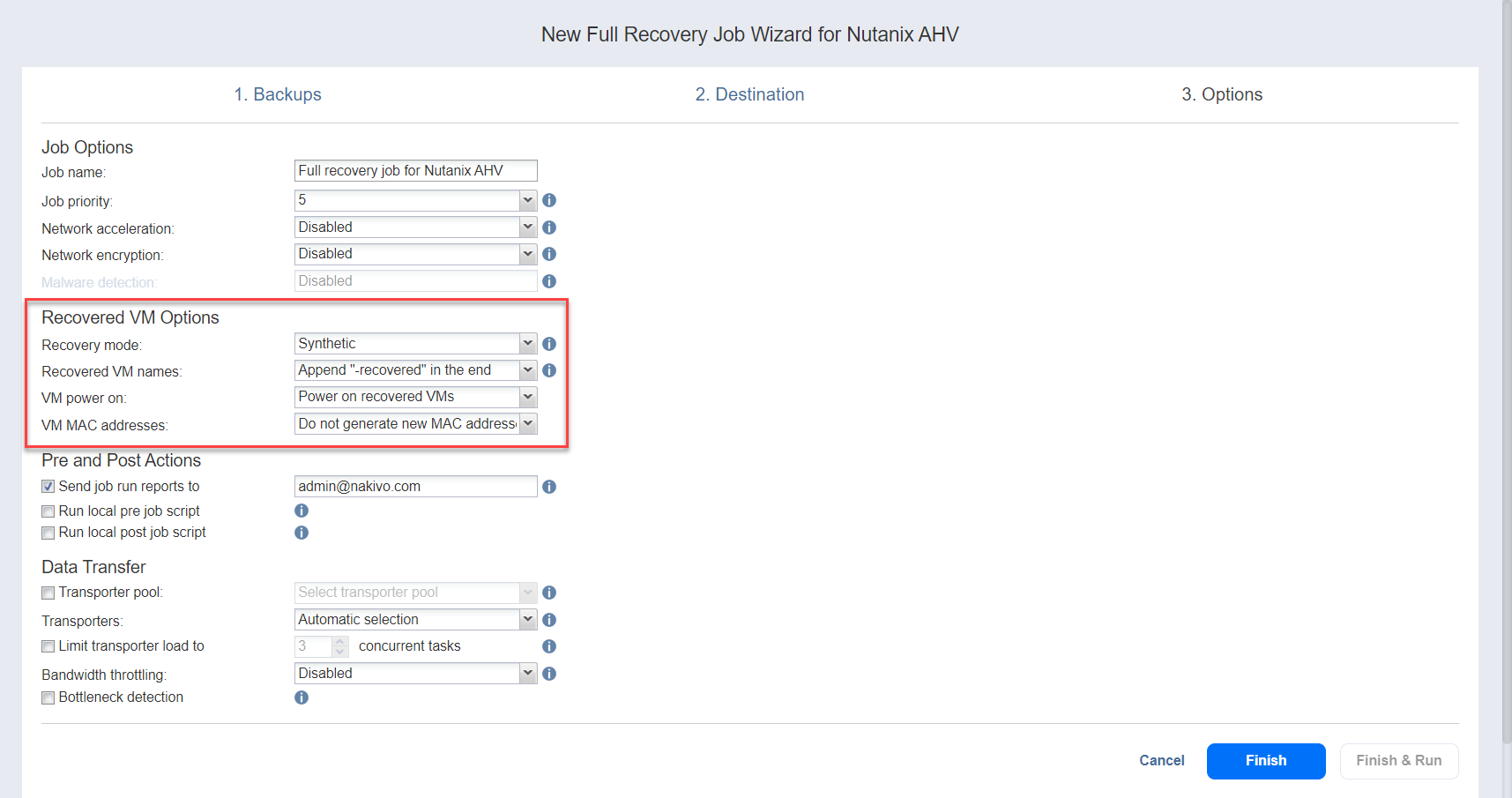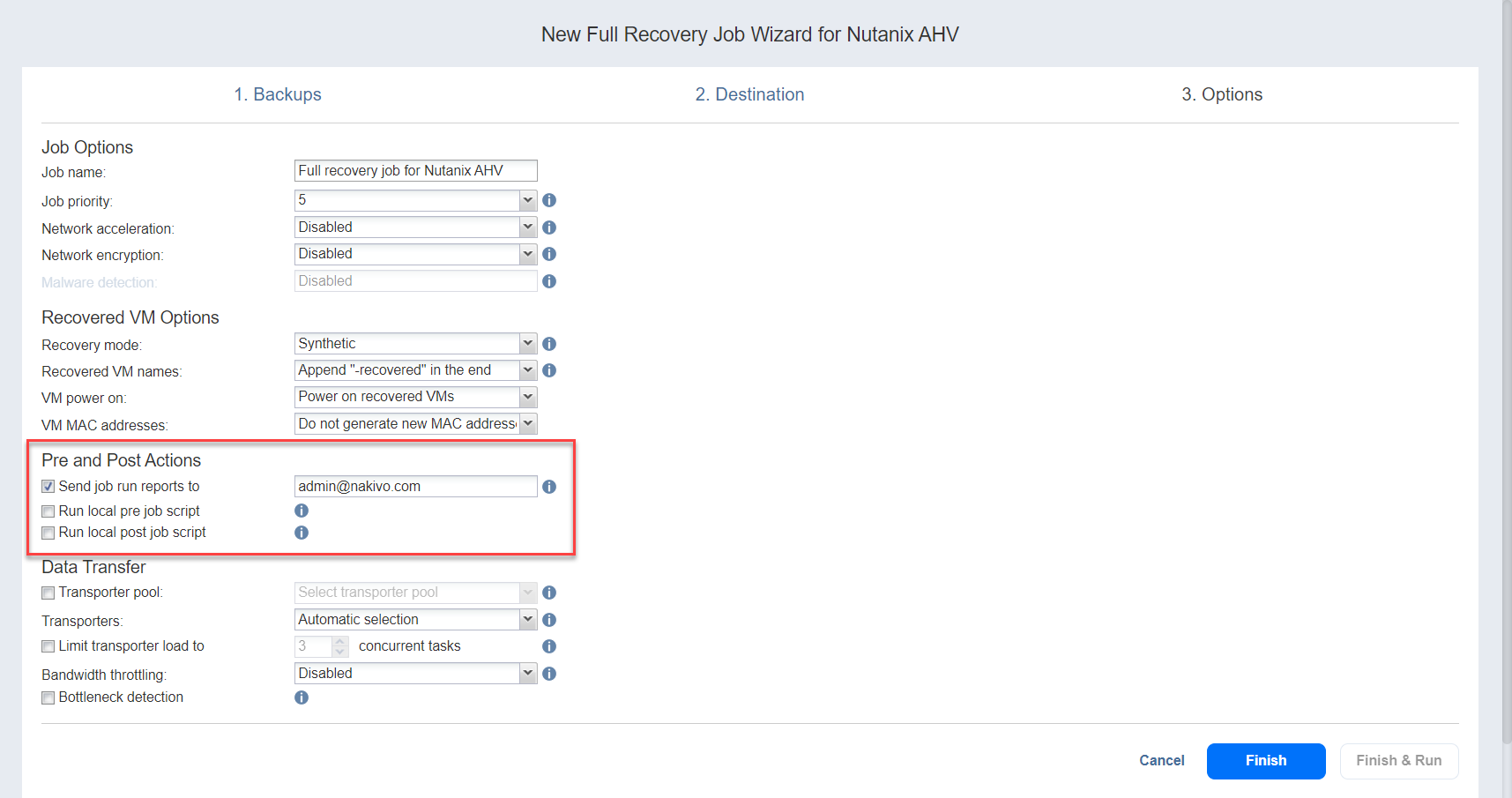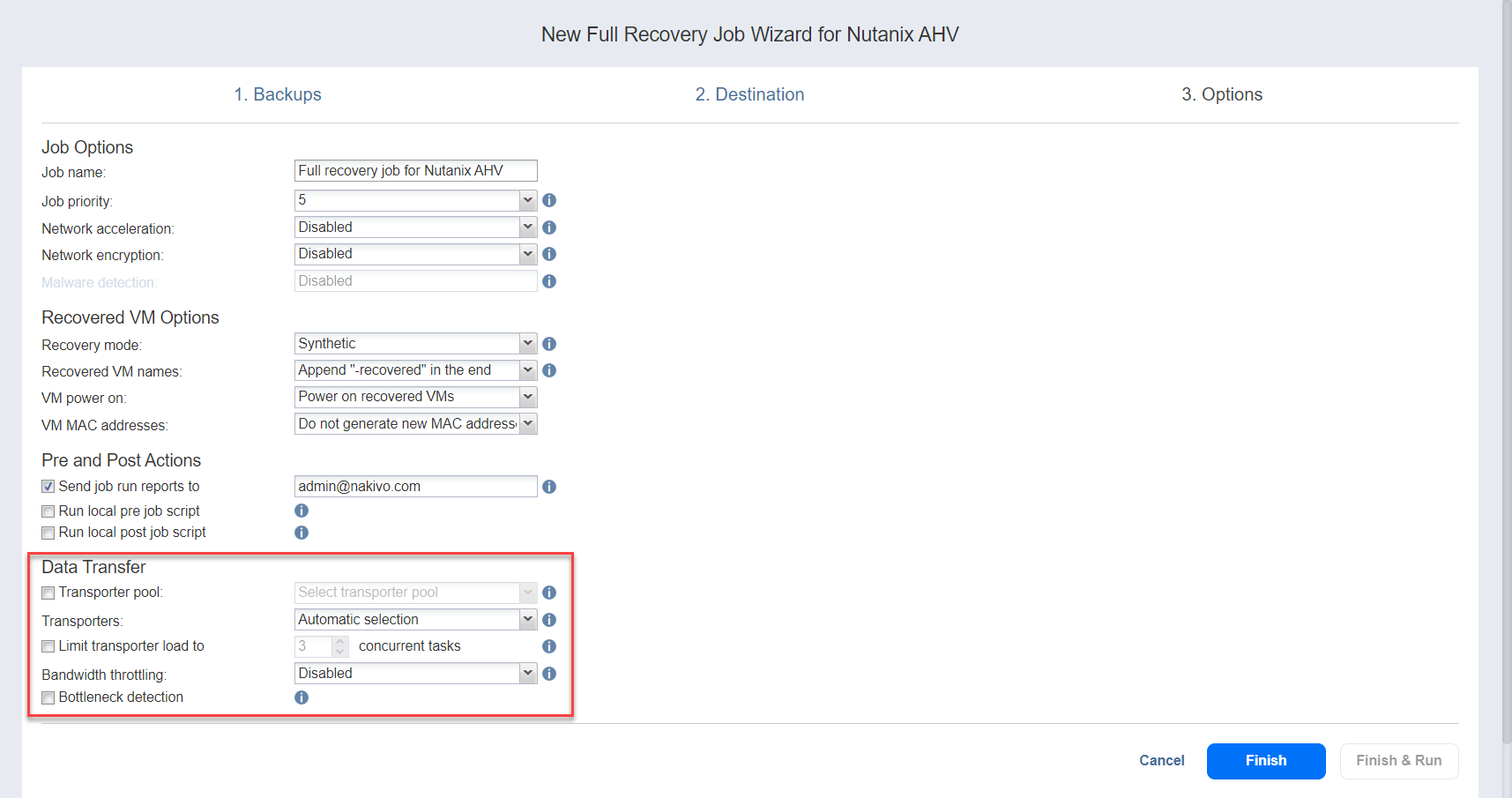Recovery Job Wizard for Nutanix AHV: Options
On the Options page, set up the recovery job options.
Job Options
Specify the general options as follows:
-
Job name: Specify a name for the recovery job.
-
Job priority: Select a job priority level between 1 and 5, with 1 being the highest priority. Jobs with higher priority levels are prioritized by Transporters during job processing.
Note
This option is only available in the Enterprise, Enterprise Essentials, Enterprise Plus, MSP Enterprise, and MSP Enterprise Plus editions. -
Network acceleration: When network acceleration is enabled, NAKIVO Backup & Replication uses compression and traffic reduction techniques to speed up data transfer. Enable this option if recovering VMs over WAN or slow LAN links.
-
Encryption: When encryption is enabled, VM data is protected with AES 256 encryption while traveling over the network. Data encryption increases the backup time and CPU load on the machines running Transporters. Select this option when recovering over WAN without a VPN connection.
- Malware detection: With this option enabled, the backups are scanned for malware using the configured antivirus software on the scan server.
-
Optionally, if you have selected Enabled for the Malware detection option, click the settings link to configure the following options:
-
Scan server: Select a specific scan server for the job or leave the Default setting. If Default is selected, the Transporter is used as the scan server and can support a maximum of 2 concurrent scan tasks.
Notes
-
For the Default option, if the Repository Transporter is the installed Transporter, it require the master password to function as the scan server.
-
For more details on the requirements for Scan Server, refer to the Feature Requirements.
-
-
Scan type: Choose between the Deep scan and the Quick scan:
-
Deep scan: When this option is selected, the antivirus software scans the entire backup and may take longer to complete.
-
Quick scan: When this option is selected, the antivirus software scans only OS disks in the backup.
-
-
If malware is detected: Choose the behavior if malware is detected:
-
Fail the recovery job: With this option, the recovery process fails in case the job has only one VM. If the job has several VMs, the infected VMs are skipped and the job continues to run.
-
Continue and recover to isolated network: When this option is selected, the recovery job completes the scanning process and recovers the infected VMs to a temporary isolated network.
-
-
Scan timeout: Specify the timeout for the malware detection process. If the specified amount of time is exceeded, the recovery job fails.
-
Click Apply when you’re done.
-
Recovered VM Options
Specify the recovery options as follows:
-
Recovery mode: Choose one of the following:
-
Synthetic: With the synthetic recovery mode selected, the VMs are recovered with the environmental dependencies (such as CPU Affinity) removed. Select this option when recovering VMs to a new location.
-
Production: With the production recovery mode selected, environment dependencies are preserved on the recovered VM(s). Make sure the location where the VM(s) will be recovered does not contain the original VM(s), otherwise UUID and MAC address conflicts may occur.
-
-
Recovered VM names: Choose one of the following:
-
Append "-recovered" in the end: Source VM names are used for recovered VM names and “-recovered” is added after the recovered VM name.
-
Leave recovered VM names as is: Recovered VM names are identical to the source VM names.
-
Enter custom recovered VM names: Allows you to enter custom names for recovered VMs.
-
-
VM power on: When the Power on recovered VMs option is chosen, the recovered VMs are powered on.
-
VM MAC addresses: Choose one of the following:
Pre and Post Actions
NAKIVO Backup & Replication allows you to run a script before VM recovery begins (a pre-job script) and after the recovery of all VMs in the job has completed (a post-job script). The scripts can only be executed on the machine where the Director is installed.
Email Notifications
NAKIVO Backup & Replication can send email notifications about the job completion status to specified recipients. This feature complements global notifications and allows you to configure notifications on a per-job level.
To enable this option, make sure that Email settings are configured.
To send email notifications, in the Pre and Post Actions section:
-
Select the Send job run reports tooption.
-
Specify one or more email addresses in the text box. Use semicolons to separate multiple email addresses.
Setting Up a Pre Job Script
To run a script before the product begins recovering VMs, do the following:
-
Place a script file on the machine where the Director is installed.
-
Select the Run local pre job script option and click the settings link.
-
Specify the following parameters in the dialog box that opens:
-
Script path: Specify a local path to the script on the machine where the Director is installed. A script interpreter should be specified.
Example (Windows): cmd.exe /c D:\script.batExample (Linux): bash /root/script.sh
-
-
Job behavior: Choose one of the following job behaviors in relation to script completion:
-
Wait for the script to finish: With this option selected, VM backup only starts after the script is completed.
-
Do not wait for the script to finish: With this option selected, the product runs the script and starts recovering VMs at the same time.
-
-
Error handling: Choose one of the following job behaviors in relation to script failure:
-
Continue the job on script failure: With this option selected, the job will recover VMs even if the script has failed.
-
Fail the job on script failure: With this option selected, if the script fails, the job will be failed and VM recovery will not be performed.
-
Setting Up a Post Job Script
To run a script after the product has finished recovering all VMs, do the following:
-
Place a script file on the machine where the Director is installed.
-
Select the Run local post job script option and click the settings link.
-
Specify the following parameters in the dialog that appears:
-
Script path: Specify a local path to the script on the machine where the Director is installed. A script interpreter should be specified.
Example (Windows): cmd.exe /c D:\script.batExample (Linux): bash /root/script.sh
-
-
Job behavior: Choose one of the following job behaviors in relation to script completion:
-
Wait for the script to finish: With this option selected, the job will be in the “running” state until the script is completed.
-
Do not wait for the script to finish: With this option selected, the job will be completed even if the script execution is still in progress.
-
-
Error handling: Choose one of the following job behaviors in relation to script failure:
-
Continue the job on script failure: With this option selected, script failure will not influence the status of the job.
-
Fail the job on script failure: With this option selected, if the script fails, the job status will be set to “failed” even if VM recovery has been successful.
-
Data Transfer
In the Data Transfer section , you can select the Transporter or Transporter pool to be used for reading data from the source VM, configure Transporter load, set bandwidth throttling, and enable bottleneck detection.
Transporter Pool
If this option is enabled, only the transporters that belong to the selected transporter pool shall be used during the job run.
Transporters
By default, the product automatically determines which Transporter should be used to read data from the source VM. However, you can also specify manually which Transporters should be used for a job.
From the Transporters drop-down list, select one of the following options:
-
Automatic selection: The product automatically determines which Transporters are the closest to source and target hosts.
-
Manual - configured for all VMs: Select this option to manually specify a single source and a single target Transporter to be used for data transfer by the job.
-
Manual - configured per cluster: Select this option to manually specify Transporters for all source and target clusters.
Bandwidth Throttling
Please follow the steps below to regulate the speed of data transfer over the network for your recovery job:
-
For the Bandwidth throttling option, choose Enabled.
Note
If bandwidth throttling is disabled for the current job, global bandwidth rules may still apply to your job. Refer to Bandwidth Throttling for details. -
Click the settings link that becomes available.
-
The Job Bandwidth Rules dialog box opens displaying the list of available rules. You have the following options:
-
Create a new bandwidth rule for your recovery job:
-
Click the Create New Rule button.
-
The New Bandwidth Rule dialog box opens. Refer to the Bandwidth Throttling topic for details on creating a bandwidth rule.
-
Click Save.
-
-
Activate an existing bandwidth rule for your job. Select the checkbox to the left of the necessary bandwidth rule. To deactivate a bandwidth rule for your job, deselect the corresponding checkbox.
-
Edit a bandwidth rule. Click the Edit link for a bandwidth rule and modify it in the Edit Bandwidth Rule dialog that opens.
-
Disable a bandwidth rule. Click the Disable link. The bandwidth rule will be disabled for all jobs.
-
Remove a bandwidth rule. Click the Remove link and then click Delete to confirm your operation.
-
Bottleneck Detection
When the Bottleneck detection option is enabled, additional information is collected and recorded in NAKIVO Backup & Replication logs in the course of data transfer for the purpose of bottleneck detection. Check this option to enable the Bottleneck detection capability of the Transporters engaged in the job.
Completing the New Full Recovery Job Wizard for Nutanix AHV
Click Finish or Finish & Run to complete the job creation.
Note
If you click Finish & Run, you will have to define the scope of your job. Refer to Running Jobs on Demand for details.



